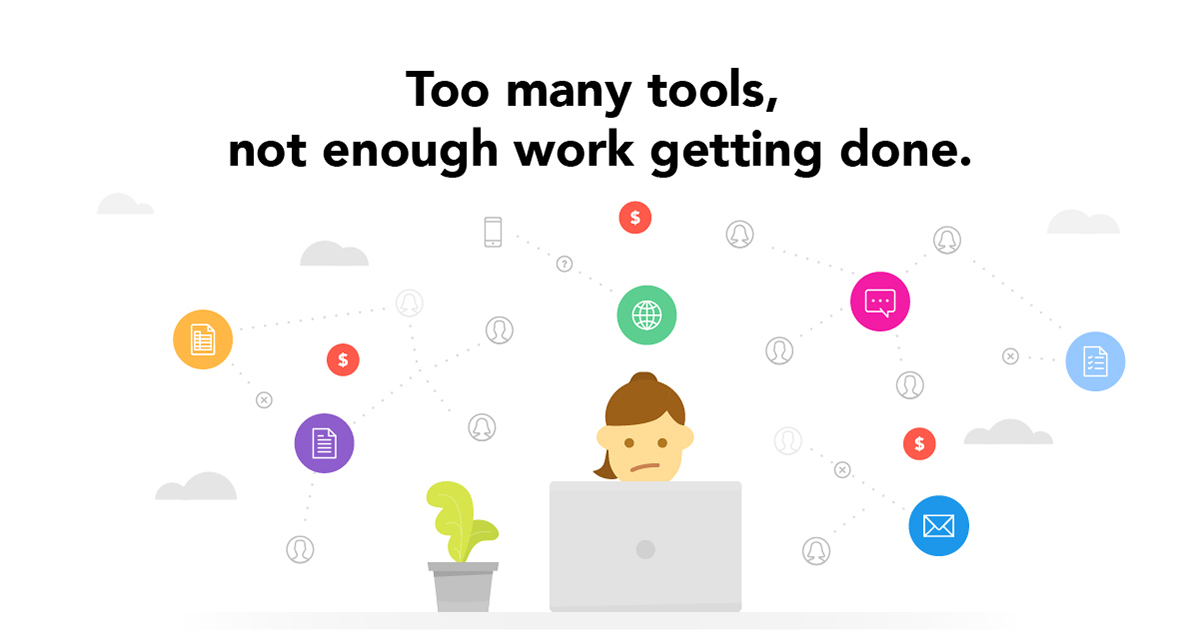The true cost of using the wrong tools at work

How many software programs do you and your team use on an average day? If you stop and think about it, there are quite a few:
- Documents
- Spreadsheets
- Project management
- CRM
- Planning
- Wiki or intranet
- Chat
That's a lot of things to spend time bouncing between. Not to mention the fact that for each of these tools on your computer, you probably have a matching app clogging up your smartphone. But the real kicker is how much it all costs. Your company could be racking up thousands of dollars per year on subscriptions and contracts.
You can probably guess where I'm going with all this: Quip can do everything those tools above can do — or add huge value by integrating with them — all with a single piece of software. It's documents, spreadsheets, and chat in one place, plus it's perfect for managing projects and using as a wiki. But subscription costs aren't the only thing your company can save on with Quip.
38% fewer meetings
Imagine what you could get done if you went to 38% fewer meetings. Imagine what your team could get done. We aren't saying all meetings are useless, or that they should be banned — but teams using Quip find that meetings just don't happen as often as they used to. Status updates and project syncs? That's already happening in Quip. Regrouping and strategizing? Also happening in Quip.
And the meetings that do take place are more efficient, because the first half of the hour isn't spent playing catchup — everyone already knows what's going on, because it's in Quip. If you consider the cost of unproductive meetings, that's a big step in the right direction.
43% less email
Email is a time sink — this isn't earth-shattering news. A recent survey tells us that by the end of 2017, the total number of emails sent and received per day will reach 269 billion. But most of us don't need statistics to tell us how much time it takes to sort, respond to, and archive email. Plus, email is simply bad for collaboration. Key decisions and conversations get buried in endless threads, leading to stalled projects and bad follow-through.
Teams using Quip sidestep a lot of this by relying on notifications and their update feeds instead. It's easier to keep track of things, and they can spend time getting actual work done.
37% less time to complete projects
Teams using Quip for their projects are getting things done a lot faster. The companies we surveyed told us that Quip had cut their project completion time by 37%, helping them build a pace that lets them move onto the next thing sooner. How are they doing it? With Quip's simple folder structure that makes team collaboration intuitive, by keeping conversations about work in the same place the work is happening, and by using checklists to sort out project tasks, assignments, and due dates.
There are things Quip adds to the equation, too..
It's not just about cutting time spent on emails and meetings, and turning your workforce into machines of efficiency. Quip also helps teams be happier and more fulfilled. Users told us that since adopting Quip, their teams' communication has improved by 50%, and overall productivity has gone up by 46%. Teams that communicate effectively and get more done together are simply happier. And that's a huge win for any company.
Get started today!
Try Quip with your team by creating a free team site at https://quip.com or download the app from the App Store or Google Play.
Already using Quip? Sign in to https://quip.com/ or launch your Quip desktop app to get started.
Data source for all statistics cited above: Average percentage improvements as reported by Quip customers, via “Quip Customer Relationship Survey,” conducted September 2016 among 683 customers.
